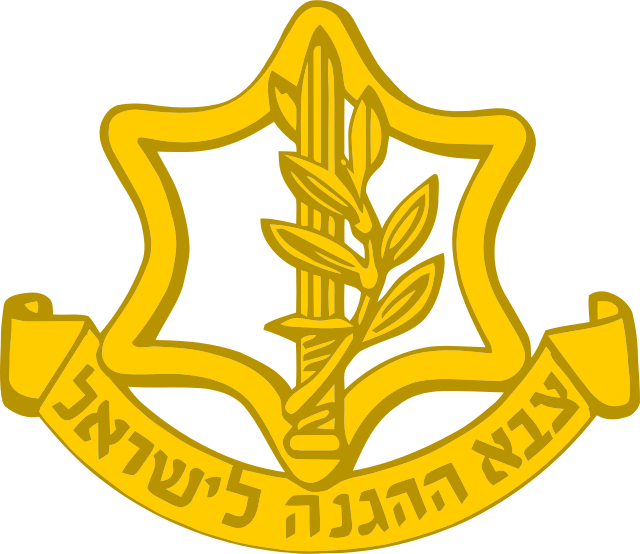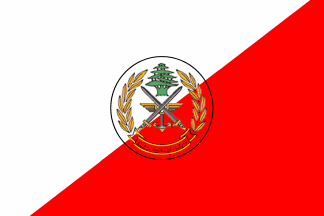Conflict Analysis Bulletin, Issue 7, August 2017

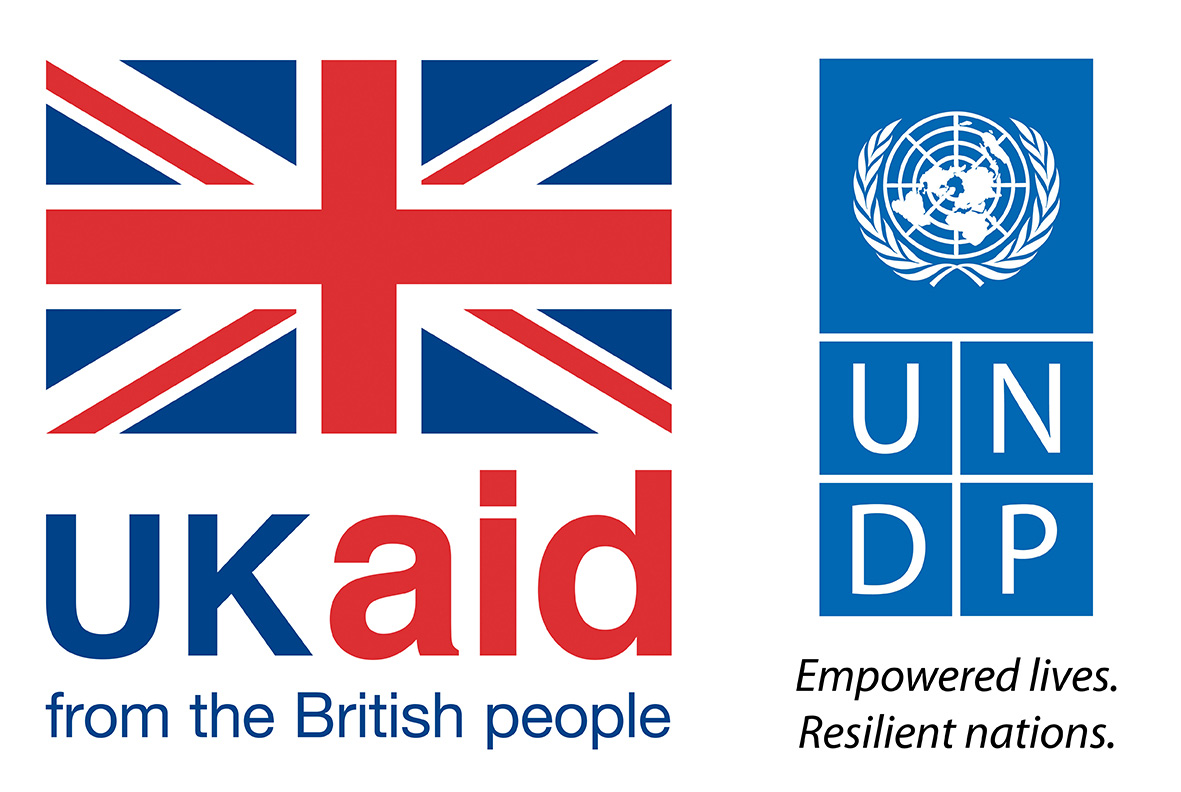

Issue 7, August 2017
About the bulletin
The Conflict Analysis bulletin, part of the Conflict Analysis Project is an initiative by Lebanon Support, with the support of the United Nations Development Programme (UNDP), available on the Civil Society Knowledge Centre (CSKC), Lebanon Support’s knowledge platform. The Conflict Analysis Project aims to make available and accessible information and research about conflicts in Lebanon, in order to better understand their underlying causes, and inform interventions and policy-making.
This bulletin features visuals focusing on conflict trends mapped during the first third of 2017. It also highlights a selection of the latest publications on the project’s page, including papers, articles, reports, visuals, and interactive content.
Defining Conflict
Going beyond the view of conflict through a security framework associated with belligerency and violence, Lebanon Support upholds that conflict is of a socio-political nature. It thus sheds light on dynamics underlying a broad spectrum of violent and non violent contentions including social movements, passing by conflicts opposing minorities (ethnic, religious or sexual among others) as well as local, national or regional actors’ policies. Read more and check the interactive conflict map here.
Main data trends from the January-April 2017 period:
- The total number of incidents mapped has slightly increased in comparison to the last 4 months of 2016.
- 50% of the incidents mapped during this period are concentrated in only 5 cazas: Beirut, Baalbeck, Tripoli, Sour, and Saida.
- Individual Acts of Violence and Border Conflicts (Israeli Borders) are the most mapped primary classification of incidents.
- Incidents categorised as collective actions saw a notable increase, and notably include mobilisation against political decisions such as tax policy, electoral law, and waste management law among others.
- Tensions in Ain el-Helweh increased, with 68 conflict incidents mapped.
1. Overview of conflict incidents mapped (from January to April 2017)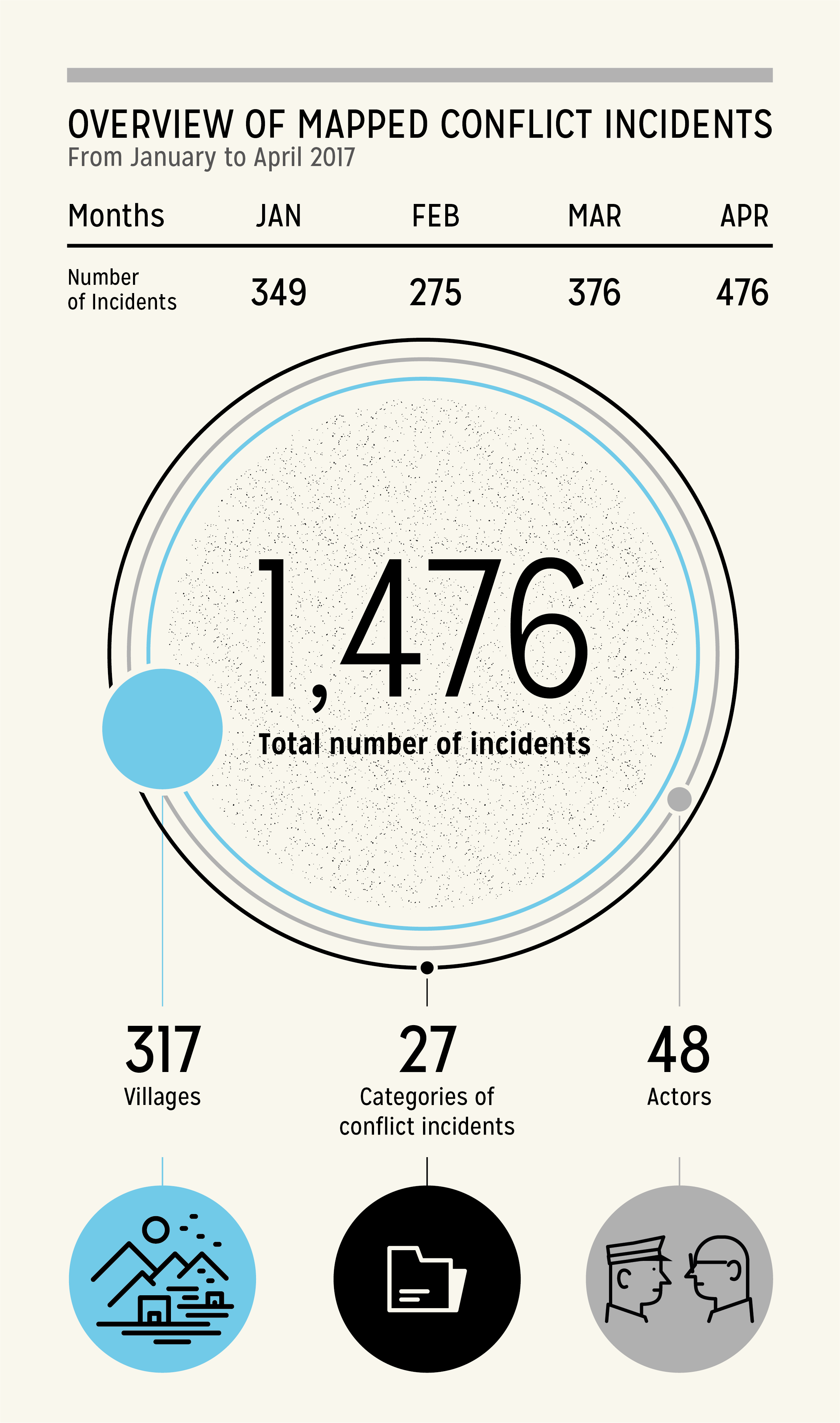
Location
The first third of 2017 witnessed a total of 1,476 conflict incidents mapped, surpassing the 1,407 incidents recorded in the first third of 2016, but slightly increasing in comparison to the last third of 2016.
Taking a closer look at the data, it is interesting to note thatSouth Lebanon was the governorate with the greatest number of incidents in the first third of the year 2017, similarly to the last third of the year 2016. Also, 39% of the mapped conflict incidents in South Lebanon (390 incidents) are primarily classified as Individual Acts of Violence (92 incidents), and 38% as Israeli Border Conflicts (119 incidents). North Lebanon (277 incidents) and Bekaa (297 incidents) follow with respectively, 58% and 61% of the incidents mapped as Individual Acts of Violence. The Nabatieh governorate was where the least number of conflict incidents was recorded, with only 164 incidents mapped, among which 67% were classified as Israeli Border Conflicts (110 incidents), 95% of which were categorised as airspace violations (92 incidents).
Finally, the number of incidents mapped in the Beirut governorate has slightly increased compared to the last third of 2016, with 193 incidents mapped (against 177 in 2016), including 74 Individual Acts of Violence and 72 Policy Conflicts.
Also, it is worth noting that over 50% of the total incidents in January-April 2017 are concentrated in only 5 cazas: Beirut, Baalbeck, Tripoli, Sour, and Saida, which represent a total of 777 incidents. Beirut and Baalbeck together account for 384 incidents (193 and 191 incidents respectively), which is equivalent to almost a quarter of the total number of incidents. In decreasing order, they are followed by the districts of Saida (157 incidents, including 68 in Ain el-Helweh refugee camp – see the third visual below for more on Ain el-Helweh), Sour (135 incidents), and Tripoli (101 incidents).
Focusing on Baalbeck, 23% of the mapped incident in the caza were located in Arsal and its outskirts (44 incidents). The latter is indicative of the ongoing Syrian Border Conflicts in Lebanon and mainly related to the ongoing clashes in Arsal between the Lebanese Armed Forces (LAF) and/or Hezbollah against armed militants affiliated to terrorist groups such as the Islamic State (IS) and Jabhat al-Sham (previously al-Nusra) as well as raids, arrests conducted by LAF.
Categories
Taking into consideration conflict categories, arrest/detention appears to be the most mapped category (506 incidents), followed by airspace violation (235 incidents), and collective action (235 incidents). These top three most mapped categories were the same during the last 4 months of 2016. They are followed by illicit trade (160), shooting (143), raid (105), robbery/trespassing (94) and brawl/dispute (85).
(Read more about primary and secondary categories here.)
Among the total number of incidents categorised as illicit trade (160 incidents), 66% of these incidents were related to drugs (105 incidents), 12% to counterfeit money (19 incidents), 8% to human smuggling (13 incidents), 7% to document forgery (11 incidents), 2% to human trafficking (3 incidents), and 2% to militant funding and support (3 incidents). The latter includes the smuggling of fuel, food, or money to militant or terrorist groups.
It is important here to highlight the difference between human smuggling and trafficking. Human smuggling involves a consensual decision among the different parties to arrive to a certain destination, and in the context of Lebanon, heavily occurs near the Syrian border. Human trafficking, however, is considered as an act of exploitation in which victims did not consent to their situation. As such, sex trafficking, for example, is considered as an act of exploitation and is strongly reprimanded by the Lebanese State with rings dismantled regularly. For instance, on March 3rd the Internal Security Forces arrested 63 individuals involved in a prostitution ring in Mkalles, where most of the victims were former domestic workers from Ethiopia.
Actors
Within the 48 mapped actors, state security apparatuses – such as the Internal Security Forces (ISF), the Lebanese Armed Forces (LAF), General Security, and State Security – are involved in 503 incidents. Focusing on the Internal Security Forces, they were involved in 277 incidents, most of which are categorised as arrest/detention (221 incidents), including 90 incidents also categorised as illicit trade/Trafficking (secondary category).
Furthermore, the Lebanese Armed Forces (LAF) are involved in 193 incidents mostly located in the Bekaa Valley (87 incidents) as well as in the Baalbek district (70 incidents). Among these incidents (193 incidents), 60% are categorised as arrest/Detention (115 incidents) with 32% of these arrests occurring after LAF conducted raids (37 incidents).
In the months of January-April 2017, 175 incidents involved Syrian Civilians/Refugees which is a decrease compared to the 226 incidents recorded in August-December 2016 and involving the same actor. However, similarly to the last third of 2016, over half of these incidents were categorised as arrest/detention (primary category), often linked to illicit trade. In fact, 28 incidents involving Syrian Civilians/Refugees are categorised as arrest/detention (primary category)and as illicit trade (secondary category). Notably, these cases where Syrians are arrested or detained were linked to human trafficking or smuggling (13 incidents), drugs (8 incidents), document forgery (4 incidents), counterfeit money (4 incidents), and militant funding and support (1 incident).
Moreover, 148 mapped incidents involved Palestinian Civilians/Refugees and heavily took place in Ain el-Helweh (68 incidents; see the third visual below for more on Ain el-Helwe) and el-Beddawi (33 incidents) refugee camps.
Moreover, it is interesting to note that the Russian Military is mapped as actor for the first time since 2015. It is involved inone incident with the Syrian Armed Forces on the Lebanese Syrian border, when three Syrian and Russian military choppers crossed over Lebanon airspace in Wadi Khaled.
2. Frequency of incidents by primary classification of conflict (from January to April 2017)
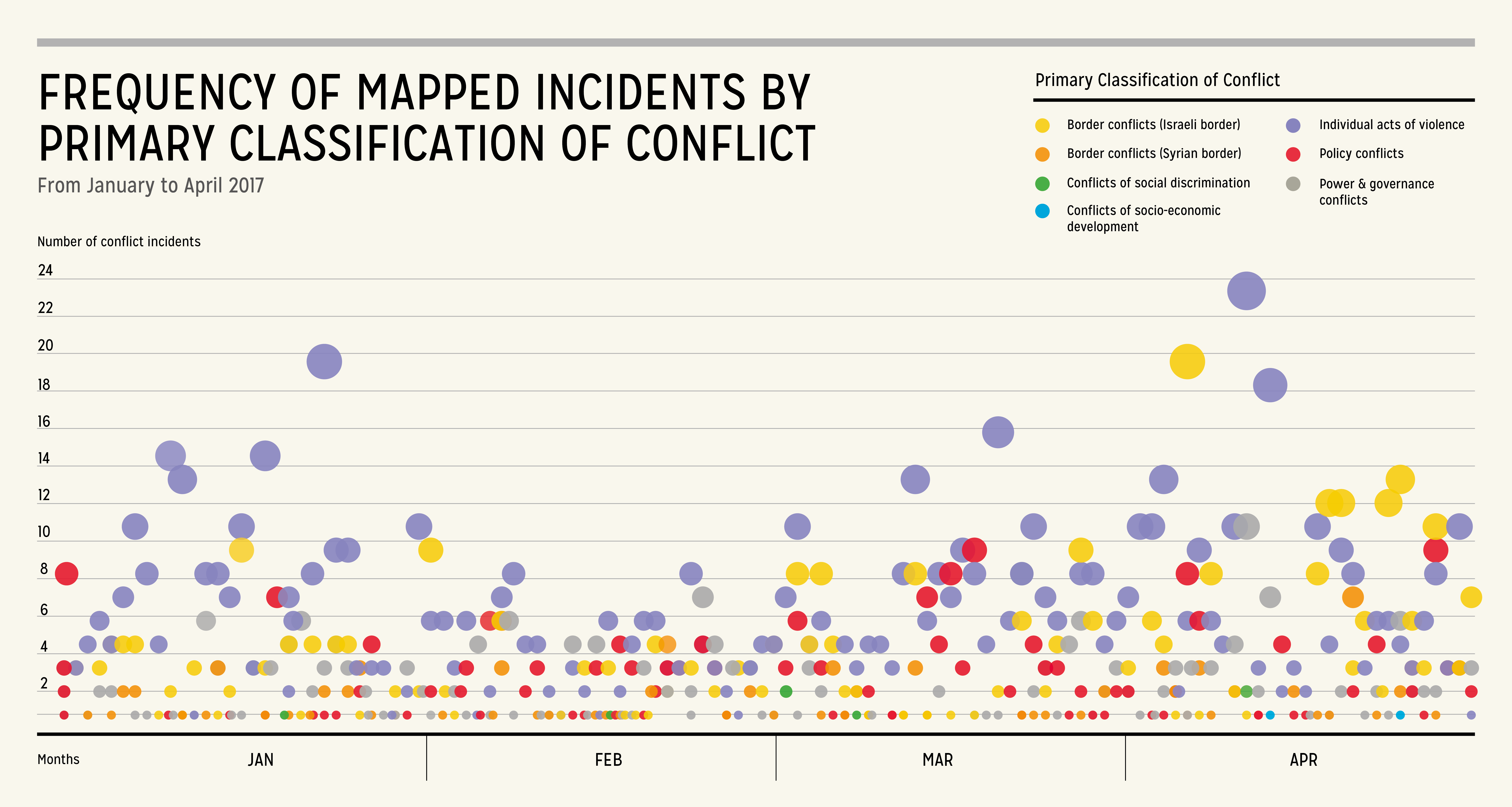
Individual Acts of Violence (638) and Border Conflicts on the Israeli border (306) have consistently been the most mapped primary classification of incidents since the beginning of the year.
This is consistent with the conflict trends recorded over the year 2016 that witnessed 1,884 incidents mapped as Individual Acts of Violence and 1,190 incidents mapped as Border Conflicts on the Israeli border. Consequently, the frequency graph above shows that both months of January and April 2017 witnessed a high number of incidents classified as Individual Acts of Violence (368 incidents), while February is associated with a decrease of Individual Acts of Violence (98 incidents).
Also, it is important to highlight that among 92 incidents primarily classified as Syrian Border Conflicts, the majority were categorised as arrests/detention (37) and raids (28) conducted against Syrian refugees.
Often, the LAF arrests Syrian refugees by large number after conducting raids. As such, one single raid operation led to the arrest of 30 Syrian refugees in Akkar on February 16th while no less than 50 were detained in a similar operation in Younine on February 21st. These incidents were also categorised as Conflicts of Social Discriminationbecause of their discriminatory nature towards Syrian refugees who are targeted on the basis of “terrorist threat” but are usually arrested for other reasons, such as illegal stay. These incidents often took place in Baalbeck, Bekaa, Saida, Zgharta, and Akkar where the main refugees camps are located.
However, while Conflicts of Social Discrimination as primary classification account for only 6 incidents in the months of January-April 2017, these discriminations rise up to a total of 78 incidents when taking into consideration both primary and secondary classification (see more about classifications here). 61% of the incidents under this classification correspond to collective actions (48 incidents) and 28% to raids (22 incidents). Among the latter, 20 raids involved Syrian Civilians/Refugees, with half of them occurring in February (10 incidents). This reveals a significant drop in raids compared to previous months (read more about trends in raid operations here).
Moreover, tensions between host communities and Syrian refugees are also prevalent during this period with 11 incidents mapped due to tensions between the two communities. These incidents included 8 collective actions, 2 brawls/disputes, and 1 raid.
Incidents mapped as Syrian Border Conflicts (128 incidents for both primary and secondary categories) involve conflicts occurring between rival groups along the Lebanese/Syrian borders, which include political parties, militant and transnational groups from both Lebanon or Syria. Consequences of the Syrian conflict in Lebanon such as clashes, bombardements, incidents with refugees, and clashes between terrorist groups also fall under this classification. In this context, Power and Governance conflicts often crosscut with Syrian Border conflicts.
Policy Conflicts witnessed a consistent surge at the start of 2017, with 205 incidents mapped as Policy Conflicts in the primary classification. Such conflicts often include a large number of collective actions, and were notably linked to specific mobilisations led by Lebanese civilians against political decisions, such as law reforms (i.e. waste management laws), electoral laws (i.e. delayed Parliamentary elections), or government's political decisions (i.e. tax policy). More specifically, over the months of January-April 2017, 11 incidents were relevant to parliamentary elections, 13 were rallies of people claiming general amnesty for detainees, and 13 were linked to rent laws.
As such, from March 15th to April 1st, 18 incidents mapped as collective actions were relevant to taxes and fiscal measures. Lebanese civilians protested across the country, and especially in Beirut (4 incidents) and Tripoli (3 incidents), against new taxes approved by the Parliament on March 15th. The new budget notably includes the controversial public sector’s salary hike bill, that would highly affect the price of everyday purchases. These mobilisations explain the peak of Policy Conflicts in mid-March seen on the visual above.
It is noteworthy to point out that incidents mapped as collective actions during this period increased steadily over the first months of 2017, with 25 incidents mapped in January, 57 incidents in February, 73 incidents in March, and over 80 incidents for the month of April. 82 of the collective actions that took place between January and April 2017 had the primary or secondary classification of conflict as Conflicts of Social Discrimination or Conflicts of Socio-economic Development.
3. Focus on the Ain el-Helweh Palestinian refugee camp (from January to April 2017)

Although conflict incidents in Ain el-Helweh have been on the rise since late 2014, with alternating periods of resurging violence and relative calm, during the first third of 2017, the camp witnessed a significant escalation of tensions.
In fact, 68 incidents were mapped within the camp during this period with 35 incidents classified as Individual Acts of Violence and 28 as Power and Governance. The rise of tensions could be explained by the dissolution of the Palestinian Joint Security Forces (JSF), which was announced on the 18th of February, due to their inability to manage security threats efficiently. In fact, just before their dissolution, the month of January witnessed the highest number of conflicts with 16 out of the 23 mapped incidents classified as Individual acts of violence mainly categorised as arrests, brawls/disputes, and explosions. The JSF dissolution also explains why the number of incidents categorised as arrests decreased significantly between February and April, since the camp did not have any legitimate security forces in charge of maintaining order during this period.
The security situation continued to deteriorate in Ain el-Helweh at the end of February with the eruption of armed clashes between Fatah militants and Islamist gunmen in which heavy artillery, rockets, and sniper fire, as well as hand grenades, were used. In fact, armed militants affiliated to Fatah, Osbat al-Ansar, Bilal Badr, and other Palestinian factions were involved in a total of 10 incidents between February and April. Moreover, the absence of Security Forces to contain the escalation of violence led to heavy LAF deployment around Ain el-Helweh in order to prevent movement in and out of the camp. Consequently, Lebanese state actors, such as the LAF and General Security among others, were involved in a total of 13 incidents between January and April 2017, mainly categorised as military deployment and arrest/detention.
Notably, in response to the increasing violence, new Palestinian Joint Security Forces were established in Ain el-Helweh on 7 April. However, the new Forces’ deployment was met with hostility by some Palestinian factions, such as Bilal Badr group which generated violent armed clashes that spanned 6 days from April 7th to April 12. Therefore, even though April witnessed the lowest number of incidents, conflicts were in fact more intense and violent with a total of 10 causalities and 54 injuries reported due to the abovementionedclashes.*
Finally, it is worth noting that 5 collective actions were mapped in Ain el-Helweh between January and April, with most of these occurring after clashes hit the camp and involving Palestinian refugees who were demanding compensation for the losses they encountered because of the armed conflicts.
* Please, note that the number of casualties and injured are those reported following each incident, and actual numbers may vary as time passes.
4. Featured mapping within the Conflict Analysis Project
The Conflictivity Index Map
The Conflictivity Index is a tool developed by Lebanon Support, in partnership with the United Nations Development Programme, based on the “Geo-located Mapping of Conflicts in Lebanon,” and using its data. Through the use of heat maps, the Conflictivity Index aims to give a broad overview of conflict intensity in Lebanon, focusing on 4 dimensions: Armed Conflict, Security, State Response, and Collective Action. Each dimension is comprised of a number of categories from the “Geo-located Mapping of Conflicts in Lebanon” and highlights the intensity of conflictuality associated with mapped incidents in each caza. Explore the Conflictivity Index maps for 2016 here.
5. Translated Spot On Actors within the Conflict Analysis Project
 Social Movement responding to the Lebanese Garbage crisis
Social Movement responding to the Lebanese Garbage crisis
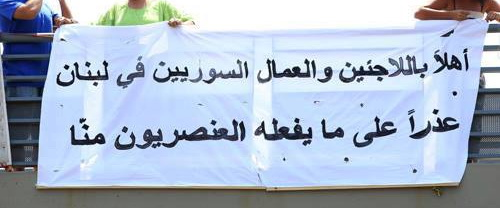 Solidarity movements for Syrian refugee rights
Solidarity movements for Syrian refugee rights
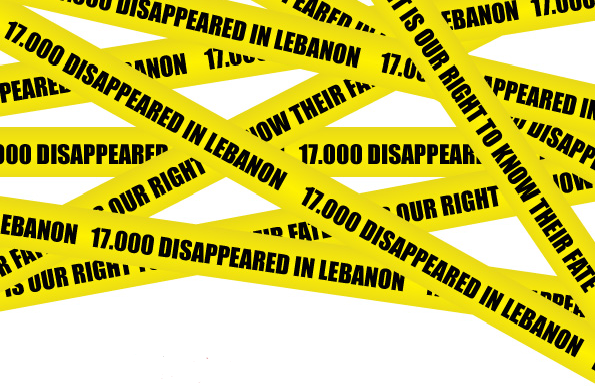 Committee of the Families of the Kidnapped and Disappeared in Lebanon
Committee of the Families of the Kidnapped and Disappeared in Lebanon
عن النشرة:
إنّ نشرة تحليل النزاعات، وهي جزء من مشروع تحليل النزاعات (Conflict Analysis Project)، هي عبارة عن مبادرة أطلقها مركز دعم لبنان بدعم من برنامج الأمم المتحدة الإنمائي ووضعها على منصة المعرفة خاصّته، أي بوابة المعرفة للمجتمع المدني. تهدف هذه النشرة إلى إتاحة المعلومات والبحوث حول النزاعات في لبنان بغية تحسين فهم أسبابها الكامنة والتأثير في عملية بلورة التدخلات ووضع السياسات.
وتتضمّن هذه النشرة موادا بصرية تُركِّز على اتجاهات النزاعات الممسوحة خلال أول أربع أشهر من السنة. كما أنها تسلط الضوء على مروحة منتقاة من أحدث المطبوعات والمنشورات على صفحة مشروع تحليل النزاعات، بما في ذلك الأوراق، والمقالات، والتقارير، والمواد البصرية، والمحتوى التفاعلي.
تعريف النزاع:
لا ينظر مركز دعم لبنان إلى العنف من منظور إطار أمني تصاحبه أعمال العنف والعدوانية، بل يتعداه ليتمسّك بموقفه القائل إنّ النزاع هو ذات طبيعة اجتماعية وسياسية. وبالتالي، يضيء المركز على الديناميات التي تحيط بمروحة واسعة من الخلافات العنيفة وغير العنيفة، بما فيها الحركات الإجتماعية مروراً بالنزاعات التي تتورّط فيها الأقليات (الإثنية أو الدينية أو الجنسية من ضمن أخرى)، بالإضافة إلى سياسات الأطراف الفاعلة المحلية أو الوطنية أو الإقليمية. إقرأ المزيد وتصفّح خريطة النزاعات التفاعلية هنا.
الاتجاهات الرئيسية للبيانات من كانون الثاني/ يناير إلى نيسان/ أبريل 2017
· ازداد العدد الكليّ للحوادث الممسوحة ازدياداً طفيفاً مقارنةً بالأشهر الأربعة الأخيرة من العام 2016.
· يتركّز 50 بالمئة من الحوادث الممسوحة خلال هذه الفترة في خمسة أقضية فقط: بيروت وبعلبك وطرابلس وصور وصيدا.
· أعمال العنف الفردية والنزاعات الحدودية (الحدود الإسرائيلية) هي الأكثر مسحاً من بين حوادث التصنيف الأولي.
· شهدت الحوادث المصنّفة كتحركاتٍ تزايداً ملحوظاً، وتضمّنت بصورةٍ خاصّة التحرّك ضدّ قراراتٍ سياسية، من قبيل السياسة الضريبية وقانون الانتخابات وقانون إدارة النفايات، من بين قراراتٍ أخرى.
· ازدادت التوترات في عين الحلوة حيث بلغ عدد حوادث النزاع الممسوحة 68 حادثاً.
1. لمحة عامة عن النزاعات الممسوحة (من كانون الثاني/ يناير إلى نيسان/ أبريل 2017)

الموقع
شهد الثلث الأول من العام 2017 مسح ما مجموعه 1476 حادث نزاع، متخطياً الحوادث المسجلة في الثلث الأول من العام 2016 والبالغة 1407 حوادث، لكن بزيادةٍ طفيفة مقارنةً بالثلث الأخير من العام 2016.
وبإلقاء نظرةٍ متفحّصة على البيانات، من المفيد ملاحظة أنّ لبنان الجنوبي كان المحافظة التي سجّلت العدد الأكبر من الحوادث في الثلث الأول من العام 2017، على نحوٍ مشابه للثلث الأخير من العام 2016. كذلك، فإنّ 39 بالمئة من حوادث النزاع الممسوحة في لبنان الجنوبي (390 حادثاً) صُنّفت أساساً كأعمال عنفٍ فردية (92 حادثاً)، و38 بالمئة منها كنزاعاتٍ حدودية على الحدود الإسرائيلية (119 حادثاً). يليها لبنان الشمالي (277 حادثاً) والبقاع (297 حادثاً) مع 58 بالمئة و61 بالمئة على التتالي من الحوادث الممسوحة كأعمال عنفٍ فردية. وقد سُجّل في محافظة النبطية العدد الأقل من حوادث النزاع بـ 164 حادثاً ممسوحاً، صُنّف 67 بالمئة منها كحوادث نزاعٍ حدودي على الحدود الإسرائيلية (110 حادثاً)، يندرج 95 بالمئة منها في فئة انتهاكات المجال الجوي (92 حادثاً).
أخيراً، ازداد عدد الحوادث الممسوحة في محافظة بيروتازدياداً طفيفاً مقارنةً بالثلث الأخير من العام 2016، حيث بلغ عددها 193 حادثاً ممسوحاً (مقابل 177 في العام 2016)، وشملت 74 حادثاً من أعمال العنف الفردية و72 حادثاً من النزاعات السياسية.
كذلك، من الجدير بالملاحظة أنّ أكثر من 50 بالمئة من إجمالي الحوادث بين شهري كانون الثاني/ يناير ونيسان/ أبريل 2017 تركّزت فقط في خمسة أقضية: بيروت وبعلبك وطرابلس وصور وصيدا، حيث مثّلت ما مجموعه 777 حادثاً. 384 حادثاً في بيروت وبعلبك معاً (193 و191 على التتالي)، ما يعادل تقريباً ربع العدد الإجمالي من الحوادث. يليها في الترتيب التنازلي مناطق صيدا (157 حادثاً، من ضمنها 68 حادثاً في مخيم عين الحلوة للاجئين ـ للمزيد عن عين الحلوة، انظر الرسم البياني الثالثة أدناه) وصور (135 حادثاً) وطرابلس (101 حادثاً).
وبتسليط الضوء على بعلبك، فقد تركّز23 بالمئة من حوادث القضاء الممسوحة في عرسال وضواحيها (44 حادثاً). تدلّ حوادث عرسال على تواصل النزاعات الحدودية على الحدود السورية في لبنان وتتعلّق أساساً بالاشتباكات المتواصلة في عرسال بين الجيش اللبناني و/أو حزب الله مع الميليشيات المسلّحة المنتمية إلى جماعاتٍ إرهابية مثل الدولة الإسلامية وجبهة الشام (النصرة سابقاً) إضافةً إلى المداهمات والتوقيفات التي يقوم بها الجيش اللبناني.
الفئات
إذا أخذنا في الحسبان فئات النزاع، يبدو أنّ فئة المداهمات/التوقيفات هي الفئة الأكثر مسحاً (506 حادثاً)، تليها فئة انتهاكات المجال الجوي (235 حادثاً) والتحركات (235 حادثاً). كانت هذه الفئات الأعلى مسحاً هي عينها في الأشهر الأربعة الأخيرة من العام 2016، تليها التجارة غير المشروعة (160)، إطلاق نار (143)، مداهمة (105)، سلب/ تعدي (94)، مشاجرة/ خلاف (85).
(لقراءة المزيد عن الفئات الأولية والثانوية اضغط هنا).
ومن بين إجمالي عدد الحوادث المصنفة كتجارة غير مشروعة (160 حادثاً)، يتعلّق 66 بالمئة منها بالمخدرات (105 حادثاً) و12 بالمئة منها بالنقود المزيفة (19 حادثاً) و8 بالمئة منها بتهريب البشر (13 حادثاً) و7 بالمئة منها بتزوير الوثائق (11 حادثاً) و2 بالمئة منها بالإتجار بالبشر (3 حوادث) و2 بالمئة منها بتمويل ودعم المقاتلين (3 حوادث). تتضمن الأخيرة تهريب الوقود والطعام والمال للمقاتلين أو الجماعات الإرهابية.
من الأهمية بمكانٍ هنا تسليط الضوء على الفارق بين تهريب البشر والإتجار بهم. إذ يتضمّن تهريب البشر قراراً توافقياً بين الأطراف المختلفة للوصول إلى وجهةٍ محددة، وفي السياق اللبناني، يحدث بكثافةٍ قرب الحدود السورية. أمّا الاتجار بالبشر، فيعدّ فعل استغلالٍ لا يوافق فيه الضحايا على وضعهم. وبالتالي، يعدّ الإتجار الجنسي على سبيل المثال عملاً استغلالياً تردعه الدولة اللبنانية بشدةٍ بتفكيك شبكاته بصورةٍ منتظمة. فعلى سبيل المثال، اعتقلت قوى الأمن الداخلي في الثالث من آذار/ مارس 63 فرداً متورطين في شبكة دعارة في بلدة مكلّس، حيث كانت غالبية الضحايا في السابق عاملاتٍ منزليات من أثيوبيا.
الأطراف الفاعلة
من ضمن الجهات الفاعلة الممسوحة الـ48، شاركت الأجهزة الأمنية ـ مثل قوى الأمن الداخلي والجيش اللبناني والأمن العام وأمن الدولة ـ في 503 حادثاً. وإذا سلّطنا الضوء على قوى الأمن الداخلي، نجد أنّها شاركت في 277 حادثاً، يصنّف معظمها في فئة التوقيف/الاحتجاز (221 حادثاً) تتضمّن 90 حادثاً تصنّف في فئة التجارة/ الإتجار غير المشروعين (فئة ثانوية).
علاوةً على ذلك، شارك الجيش اللبناني في 193 حادثاً يقع معظمها في وادي البقاع (87 حادثاً) إضافةً إلى منطقة بعلبك (70 حادثاً). من بين هذه الحوادث (193 حادثاً) هنالك 60 بالمئة منها مصنّفة ضمن فئة التوقيف/الاحتجاز (115)، وحدث 32 بالمئة من هذه الاعتقالات بعد قيام الجيش اللبناني بالمداهمات (37 حادثاً).
في الأشهر من كانون الثاني/ يناير إلى نيسان/ أبريل 2017، تعلّق 175 حادثاُ بلاجئين/ مدنيين سوريين، وشكّل ذلك انخفاضاً مقارنةً بـ226 حادثاً مسجّلاً في الفترة بين شهري آب/ أغسطس وكانون الأول/ ديسمبر 2016 قام بها الطرف الفاعل عينه. لكنّ أكثر من نصف هذه الحوادث، على نحوٍ مشابهٍ للثلث الأخير من العام 2016، صُنّف ضمن فئة التوقيف/الاحتجاز (فئة أولية)، وقد ارتبط في كثيرٍ من الحالات بالتجارة غير المشروعة. في الحقيقة، صُنّف 28 حادثاً تتعلّق بلاجئين/ مدنيين سوريين ضمن فئة التوقيف/الاحتجاز (فئة أولية) وضمن فئة التجارة غير المشروعة (فئة ثانوية). الجدير بالذكر أنّ هذه الحالات التي تعرّض فيها سوريون للتوقيف أو الاحتجاز ترتبط بالإتجار بالبشر أو تهريبهم (13 حادثاً) وبالمخدّرات (8 حوادث) وبتزوير الوثائق (4 حوادث) والنقود المزيفة (4 حوادث) وتمويل ودعم المقاتلين (حادث واحد).
فضلاً عن ذلك، تضمّن 148 حادثاً ممسوحاً لاجئين/ مدنيين فلسطينيين، وقد حدث معظمها في مخيمي عين الحلوة (68 حادثاً؛ للمزيد عن عين الحلوة، انظر المادة البصرية الثالثة أدناه) والبدّاوي (33 حادثاً).
علاوةً على ذلك، من المثير للاهتمام ملاحظة أنّه جرى مسح الجيش الروسي كطرفٍ فاعلٍ للمرّة الأولى منذ العام 2015. فقد شارك في حادثٍ واحدٍ مع الجيش السوري على الحدود السورية اللبنانية عندما عبرت ثلاث مروحيّات سورية وروسية المجال الجوي اللبناني في وادي خالد.
2. تواتر النزاعات بحسب التصنيف الأوَّلي للنزاع (من كانون الثاني/ يناير إلى نيسان/ أبريل 2017)

لقد ظلّت أعمال العنف الفردية (638) والنزاعات الحدودية على الحدود الإسرائيلية (306) أكثر حوادث التصنيف الأولي الممسوحة منذ مطلع العام.
يتماشى هذا الأمر مع اتجاهات النزاع المسجلة خلال العام 2016 والتي شهدت 1884 حادثاً ممسوحاً من أعمال العنف الفردية و1190 حادثاً ممسوحاً من النزاعات الحدودية على الحدود الإسرائيلية. وبناءً على ذلك، يظهِر تواتر الشكل البياني أعلاه أنّ كلاً من شهري كانون الثاني/ يناير ونيسان/ أبريل 2017 قد شهدا عدداً مرتفعاً من حوادث تصنّف ضمن فئة أعمال العنف الفردية (368 حادثاً)، في حين اقترن شهر شباط/ فبراير بانخفاض عدد أعمال العنف الفردية (98 حادثاً).
كذلك، من الأهمية بمكان تسليط الضوء على أنّه من بين 92 حادثاً صُنّفت أساساً بوصفها نزاعاتٍ على الحدود السورية، صُنّف معظمها ضمن فئة التوقيف/الاحتجاز (37) والمداهمات (28) التي استهدفت لاجئين سوريين.
يقوم الجيش اللبناني في كثيرٍ من الحالات باعتقال اللاجئين السوريين بأعدادٍ كبيرة بعد المداهمات. وعلى هذا، أدّت عملية مداهمةٍ واحدة إلى اعتقال 30 لاجئاً سورياً في عكّار بتاريخ 16 شباط/ فبراير، في حين جرى توقيف ما لا يقلّ عن 50 لاجئاً سورياً في عمليةٍ مشابهةٍ جرت في يونين بتاريخ 21 شباط/ فبراير 2016. كما أنّ هذه الحوادث صُنّفت ضمن النزاعات المرتبطة بالتفرقة الاجتماعية بسبب طبيعتها المتّسمة بالتفرقة تجاه اللاجئين السوريين المستهدفين على أساس "التهديد الإرهابي" لكنّهم يعتقلون عادةً لأسبابٍ أخرى، من قبيل الإقامة غير القانونية. غالباً ما تقع هذه الحوادث في بعلبك والبقاع وصيدا وزغرتا وعكّار، حيث توجد مخيّمات اللاجئين الرئيسية.
وعلى الرغم من أنّ النزاعات المرتبطة بالتمييز الإجتماعي بوصفها تصنيفاً أولياً لم تسجّل إلا 6 حوادث في الأشهر من كانون الثاني/ يناير إلى نيسان/ أبريل 2016، فإنّ عدد حوادث التفرقة هذه يصل إلى ما مجموعه 78 حادثاً حين نأخذ بالحسبان كلا التصنيفين الأولي والثانوي (انظر المزيد حول التصنيفات هنا). يتطابق 61 بالمئة من هذه الحوادث المندرجة ضمن هذا التصنيف مع فئة التحركات (48 حادثاً) و28 بالمئة مع فئة المداهمات (22 حادثاً). ومن بين الأخيرة، تضمّنت 20 مداهمةً لاجئين/ مدنيين سوريين، حدث نصفها في شهر شباط/ فبراير (10 حوادث). يبيّن ذلك انخفاضاً ملحوظاً في المداهمات مقارنةً بالأشهر السابقة (اقرأ المزيد حول الاتجاهات في عمليات المداهمة هنا).
علاوةً على ذلك، سادت التوتّرات بين المجتمعات المضيفة واللاجئين السوريين أثناء هذه الفترة بـ11 حادثاً ممسوحاً بسبب التوتّرات بين هاتين الجماعتين. تتضمّن هذه الحوادث 8 حوادث من فئة التحركات وحادثين من فئة المشاجرة/ الخلاف وحادثاً من فئة المداهمة.
تتضمّن الحوادث الممسوحة كنزاعاتٍ على الحدود السورية (128 حادثاً للفئات الأولية والثانوية) نزاعاتٍ حدثت بين مجموعاتٍ متنافسة على طول الحدود السورية اللبنانية، وقد ضمّت أحزاباً سياسية ومقاتلين وجماعاتٍ عابرة للحدود من لبنان وسوريا. كما أنّ النتائج المترتّبة على النزاع السوري الاشتباكات والقصف المدفعي والحوادث مع اللاجئين والاشتباكات بين المجموعات الإرهابية تندرج ضمن هذا التصنيف. وفي هذا السياق، تتقاطع النزاعات على السلطة والحكم مع النزاعات على الحدود السورية.
شهدت النزاعات السياسية تصاعداً مستمراً في مطلع العام 2017، حيث بلغ عدد الحوادث الممسوحة ضمن فئة النزاعات السياسية في التصنيف الأولي 205 حادثاً. غالباً ما تضم هذه النزاعات عدداً كبيراً من التحركات، وترتبط على نحوٍ ملحوظ بتحركاتٍ نوعيةٍ يقودها مدنيون لبنانيون ضد قراراتٍ سياسية مثل الإصلاحات القانونية (قوانين إدارة النفايات على سبيل المثال) أو قوانين الانتخابات (تأجيل الانتخابات النيابية على سبيل المثال) أو القرارات السياسية للحكومة (السياسة الضريبية على سبيل المثال). وعلى نحوٍ أكثر تحديداً، تعلّق 11 حادثاً خلال الأشهر من كانون الثاني/ يناير إلى نيسان/ أبريل 2017 بالانتخابات البرلمانية، وتعلّق 13 حادثاً بمسيراتٍ تطالب بالعفو العام، كما ارتبط 13 حادثاً بقوانين الإيجار.
وعلى هذا، ارتبط من 15 آذار/ مارس إلى 1 نيسان/ أبريل 18 حادثاً ممسوحاً كتحركاتٍ بإجراءاتٍ ماليةٍ وضريبية. احتجّ مدنيون لبنانيون في أرجاء البلد، لاسيما في بيروت (4 حوادث) وطرابلس (3 حوادث) على ضرائب جديدة أقرّها المجلس النيابي في 15 آذار/ مارس. تتضمّن الميزانية الجديدة بصورةٍ خاصّة القانون الخلافي المتعلّق برفع رواتب موظفي القطاع العام والذي سيؤثّر كثيراً في أسعار المشتريات اليومية. تفسّر هذه التحركات ذروة النزاعات السياسية في منتصف آذار/ مارس المشاهدة في الرسم البياني أعلاه.
تجدر الإشارة إلى أنّ الحوادث الممسوحة كتحركاتٍ في هذه الفترة تزايدت باستمرارٍ خلال الأشهر الأولى من العام 2017، حيث بلغ عدد الحوادث الممسوحة في كانون الثاني/ يناير 25 حادثاً، و57 حادثاً في شباط/ فبراير و73 حادثاً في آذار/ مارس وأكثر من 80 حادثاً في شهر نيسان/ أبريل. وقد صُنّف 82 حادثاً من التحركات التي حدثت بين شهري كانون الثاني/ يناير ونيسان/ أبريل ضمن التصنيف الأوّلي أو الثانوي بوصفها نزاعاتٍ مرتبطة بالتفرقة الاجتماعية أو نزاعاتٍ مرتبطة بالتنمية الاجتماعية -الاقتصادية.
3. إضاءة على مخيم عين الحلوة للاجئين الفلسطينيين (من كانون الثاني/ يناير إلى نيسان/ أبريل 2017)

على الرغم من أنّ حوادث النزاع في عين الحلوة كانت في تصاعدٍ منذ نهاية العام 2014 مع فتراتٍ متناوبة من معاودة العنف والهدوء النسبي، إلا أنّ المخيم شهد تسارعاً ملحوظاً في التوتّرات أثناء الثلث الأول من العام 2017.
واقع الأمر أنّه من بين 68 حادثاً مٌسحت ضمن المخيم في هذه الفترة، صنّف 35 منها كأعمال عنفٍ فردية و28 كنزاعات على السلطة والحكم. قد يفسَّر تصاعدَ التوترات حلُّ قوات الأمن المشتركة الفلسطينية الذي أُعلن عنه في 18 شباط/ فبراير بسبب عجزها عن التعامل مع التهديدات الأمنية بفعّالية. في الحقيقة، شهد شهر كانون الثاني/ يناير قبيل حل تلك القوّات العدد الأعلى من النزاعات، حيث صُنّف 16 حادثاً من أصل 23 حادثاً ممسوحاً كأعمال عنفٍ فردية تندرج أساساً ضمن فئات التوقيفاتوالمشاجرات/ الخلافات والتفجيرات. كما أنّ حلّ قوات الأمن المشتركة يفسّر سبب الانخفاض الملحوظ لعدد الحوادث المصنّفة ضمن فئة التوقيفات بين شهري شباط/ فبراير ونيسان/ أبريل، لأنّه لم يكن في المخيم قوات أمنٍ شرعيةٍ مسؤولةٍ عن حفظ النظام في تلك الفترة.
واصل الوضع الأمني تدهوره في عين الحلوة في أواخر شباط/ فبراير باندلاع اشتباكاتٍ مسلحة بين مقاتلي فتح ومسلّحين إسلاميين، استخدمت فيها المدفعية الثقيلة والصواريخ ونيران القنص وكذلك القنابل اليدوية. واقع الأمر أنّ مقاتلي فتح المسلّحين وعصبة الأنصار وبلال بدر وفصائل فلسطينية أخرى شاركت في إجمالي 10 حوادث بين شهري شباط/ أبريل ونيسان/ أبريل. علاوةً على ذلك، أدّى غياب قواتٍ أمنية تحتوي تفاقم العنف إلى نشرٍ كثيفٍ للجيش اللبناني حول عين الحلوة لمنع حركة الدخول إلى المخيم والخروج منه. تبعاً لذلك، شاركت الأطراف الفاعلة في الدولة اللبنانية، كالجيش اللبناني والأمن العام من بين آخرين، بين شهري شباط/ فبراير ونيسان/ أبريل في إجمالي 13 حادثاً صُنّفت أساساً في فئتي نشر الجيش والتوقيف/الاحتجاز.
من الجدير بالذكر أنّه رداً على تزايد العنف، شُكّلت في عين الحلوة قوات أمنٍ مشتركة فلسطينية جديدة في 7 نيسان/ أبريل. لكنّ نشر القوات الجديدة قوبل بالعداء من قبل بعض الفصائل الفلسطينية مثل جماعة بلال بدر، ما أسفر عن اشتباكاتٍ مسلّحة امتدّت لستة أيام من 7 نيسان/ أبريل إلى 12 نيسان/ أبريل. بالتالي، وعلى الرغم من أنّ شهر نيسان/ أبريل شهد العدد الأقلّ من الحوادث، إلا أنّ النزاعات كانت في الواقع أكثر حدّةً وعنفاً، حيث بلغ عدد الإصابات ما مجموعه 10 ضحايا و54 جريحاً، ذُكر بأنّها نتجت عن الاشتباكات المذكورة أعلاه*.
أخيراً، من الجدير بالملاحظة أنّ 5 تحركاتٍ مُسحت في عين الحلوة بين شهري كانون الثاني/ يناير ونيسان/ أبريل، وقد حدث معظمها بعد الاشتباكات التي أصابت المخيم وشارك فيها اللاجئون الفلسطينيون الذين طالبوا بالتعويض عن الخسائر التي لحقت بهم بسبب النزاعات المسلحة.
* ملاحظة: إنّ عدد الضحايا والجرحى هو المذكور بعد كلّ حادث، وقد تختلف الأعداد الحقيقية بمرور الوقت
4. خريطة رئيسية ضمن مشروع مسح النزاعات وتحليلها
خريطة مؤشر الحالة النزاعية
إنّ خريطة مؤشر الحالة النزاعية هي أداةٌ طورها مركز دعم لبنان بالشراكة مع برنامج الأمم المتحدة الإنمائي، تستند إلى "خريطة مسح النزاعات في لبنان"، وتستخدم بياناتها. من خلال استخدام خرائط شدّة المخاطر، يهدف مؤشّر الحالة النزاعية إلى تقديم لمحةٍ عامّةٍ واسعة النطاق لشدّة النزاع في لبنان وتسليط الضوء على أربعة أبعاد: النزاع المسلح والأمن واستجابة الدولة والتحرّك الشعبي. يتكوّن كل بعدٍ من عددٍ من الفئات من "خريطة المواضع الجغرافية للنزاعات في لبنان" ويسلّط الضوء على شدّة الحالات النزاعية، مقترنةً بالحوادث الممسوحة في كلّ قضاء. استكشف خرائط مؤشّر الحالة النزاعية للعام 2016 هنا.
5. إضاءاة على الأطراف الفاعلة مترجمة
 استجابة الحركة الاجتماعية لأزمة النفايات في لبنان
استجابة الحركة الاجتماعية لأزمة النفايات في لبنان
 حركات التضامن من أجل حقوق اللاجئين السوريين
حركات التضامن من أجل حقوق اللاجئين السوريين



